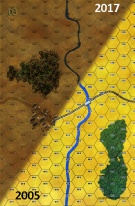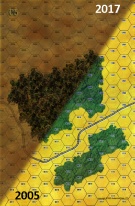|
Pinning Attack Eastern Front #41 |
||
|---|---|---|
| (Defender) Germany | vs | Soviet Union (Attacker) |
| Formations Involved | ||
|---|---|---|
| Germany |  |
3rd Panzergrenadier Division |
| Soviet Union |  |
21st Tank Division |

|
| Overall Rating, 5 votes |
|---|
|
3.2
|
| Scenario Rank: 636 of 957 |
| Parent Game | Eastern Front |
|---|---|
| Historicity | Historical |
| Date | 1941-07-15 |
| Start Time | 09:30 |
| Turn Count | 36 |
| Visibility | Day |
| Counters | 94 |
| Net Morale | 1 |
| Net Initiative | 2 |
| Maps | 2: 3, 6 |
| Layout Dimensions | 56 x 43 cm 22 x 17 in |
| Play Bounty | 84 |
| AAR Bounty | 166 |
| Total Plays | 5 |
| Total AARs | 1 |
| Battle Types |
|---|
| Covering Action |
| Inflict Enemy Casualties |
| Rural Assault |
| Conditions |
|---|
| Off-board Artillery |
| Randomly-drawn Aircraft |
| Scenario Requirements & Playability | |
|---|---|
| Eastern Front | Base Game |
| Introduction |
|---|
|
While 8th Panzer Division fought for its life against "an enemy well-supplied with artillery and armor," even heavier attacks fell on its neighbor. As the 237th Rifle Division, a Finnish-speaking unit from Karelia, filtered around the 3rd Motorized Division's right flank, the badly-equipped 21st Tank Division held the German's attention with what seemed another in a series of fruitless frontal assaults. |
| Conclusion |
|---|
|
The Germans fought off the Soviet tankers. the 221st had only entered combat on 10 July, and by the end of its first week almost all of its outmoded tanks had been lost. But their sacrifice had done its part, and the 3rd Motorized had to fall back in a rapid retreat after finding its flank being rolled up. |
| AFV Rules Pertaining to this Scenario's Order of Battle |
|---|
|
| 3 Errata Items | |
|---|---|

|
The reduced direct fire value of the Heer HMG became 5-5 starting with Fall of France. (plloyd1010
on 2015 Jul 31)
|

|
The reduced direct fire value in Kursk: Burning Tigers is 4-4. (plloyd1010
on 2015 Jul 31)
|

|
Kommissars never get morale or combat modifiers. Ignore misprints. (Shad
on 2010 Dec 15)
|
| Infiltrate at all costs | ||||||||||||
|---|---|---|---|---|---|---|---|---|---|---|---|---|
This one turned out to be a lot tougher for the Germans than I expected; in order for them to win they have to eliminate 20 Soviet steps (the easier part) and prevent any Soviet units from getting past their postions on board 3 (east) and occupying any hex on board 6 (west) by the end of play. The Soviets only have to prevent the Germans from winning as if neither player wins the result is a Soviet victory. The Soviet VCs require them to eliminate 10 German steps and clear board 3 of all German units. If both players win then the game ends in a draw. So it was very clear for a Soviet victory; no matter what the casualties just get one unit to board 6 and keep it alive until the scenario's end. The Germans set-up first, west of the river on boards 3 and 6, with most units posted in the town and a few in the woods north of it to prevent a flanking manuever. The 37mm AT guns were placed by the north and south edges of the town with one far back on the road on board 6 as a last line of defense should Soviet tanks break through the first lines of defense. The Soviets then set-up second anywhere east of the river. Cleverly, two triple stacks of T-26s are deployed in the woods across from the river taking advantage of the fact that only one of the 37mm AT guns could spot them there and that they would have to fire at long range to hit the Soviet tanks. That, along with the cover of woods would make it so that one 37mm would have to roll "12"s to score a hit on them. Also, both of those triple stacks of T-26s would have the German HMGs in the eastern-most town hex just in DF range to effectively roll on the 7 column of the DF table. So already a flaw was found in the German deployment before the first turn commenced. The Soviets begin with only about one truck for every two Soviet units which is no problem. Half of the foot units begin poised to cross the bridge in the first attack wave unmounted while the other half stay loaded on trucks in the cover of the woods as a back-up for the second wave. The die is cast and the Soviets gain the intiative. The first wave charges across the bridge with SMG units leading the way and the combination of HMG opportunity fire and German OBA takes out a whole platoon and eliminates a Soviet Lieutenant right away. The first Soviet wave gets hammered and losses pile up very quickly the first few turns along with some nasty batches of friendly fire but they manage to keep enough units across the bridge to contest the Germans. Then room is made for the second mobile wave to cross the bridge and reinforce right in time while the T-26s continue to strafe the town from the other side of the river. The Germans do have a chance of recieving air support each turn but it rarely shows up needing to roll a 6(D6). In the course of the first 21 turns the Luftwaffe only appeared once and had very little effect when it did. So what developed was a very long tug-of-war match for control of the town and though Soviet losses are close to 3 to every German loss, slowly the Germans start to lose footing and are desperately trying to maintain a solid line so that no units could break through. Meanwhile a diversion is set-up with some Soviet units trying to sneak around the town through the northern woods. All the while the T-26s wait patiently for their moment to roll on over for support. Eventually the Soviets are able to take most of the town and many German units had to be diverted to chase down units in the northern woods before they could cross over to board 6. This stretched the German defenses quite thin, which was the intention. Soon one of the 37mm AT guns is eliminated and another disabled giving the armada of T-26s the thumbs-up to make their crossing. Once they cross the river the pressure is really on. German units have been pushed back to the edges of the town and a very large combined Soviet force is massed on their south flank. The Germans did manage to secure their north flank and eliminate all would-be infiltrators there but they are not able to backtrack in time to prevent the inevitable. Waiting until enough time had passed and German forces weakened in number and strength the big push west was made with both Soviet foot and armored units scattering across to board 6. German OBA and a few lucky 37mm shots take out or disable a few T-26 steps but it is not enough. Hunting parties of German INF units try their best stop the Soviet drive west through assaults but they're not able to catch up with them all and it becomes clear that it is a losing race for Germany. At a certain point Soviet units have made it far enough behind German lines that units which fail to recover from demoralization only end up fleeing deeper into German territory, most into the western woods. Oddly enough German air-support finally begins showing up more frequently after all is lost. The Luftwaffe did manage to eliminate one reduced and demoralized unit that had fled into the woods but that was it and not enough to make a substantial difference. The Germans spent the last few turns going through the motions but by the time the scenario ended with the conclusion of turn 36 there were 2 platoons of T-26s and a Soviet INF unit left on board 6 gving the Soviets the win. It was no walk in the park for the Soviets, they really did have to push hard to breakthrough the lines and the human cost was very high. Soviet losses were: 3 leaders (including their Colonel), 1 Kommisar, 23 INF, 5 SMG, 6 HMG, 2 KMS and 7 steps of T-26. German losses: 2 leaders, 9 INF, 6 HMG, 1x37mm AT and 3 trucks. Rated a "4" for the challenge aspect of it all as it was gruelling for both sides yet do believe play is somewhat balanced. In this case the Soviets had to wait patiently for the right time to bring the T-26s into close action and then wait for the right time and opportunity to gamble all and make a dash to get behind the German lines. Though there was a lot of battle in this one it required more tactful manuvering, flanking and overall timing to bring about this Soviet victory. |
||||||||||||
| 0 Comments |

 EFDx040
EFDx040 





















